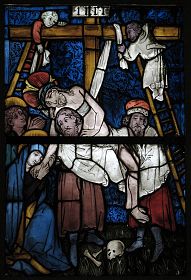


Stained Glass Panel with the Deposition
Stained Glass Panel with the DepositionStained Glass Panel with the Deposition
Middle Rhine, Germany, 15th century
Medium : Pot-metal, white glass, vitreous paint
Dimensions : Overall (with 1 T-bar): 43 1/2 x 29 5/16 x 3/8 in. (110.5 x 74.5 x 1 cm)
Overall (installation opening): 41 3/4 x 28 3/8 in. (106 x 72.1 cm)
a: 21 7/8 x 29 1/4 x 3/8 in. (55.6 x 74.3 x 1 cm)
b: 21 3/4 x 29 1/4 x 3/8 in. (55.2 x 74.3 x 1 cm)
Credit Line : Francis L. Leland Fund, 1913
THE MET
https://www.metmuseum.org/art/collection/search/463645?where=Germany&showOnly=openAccess&ft=stained+glass+rhine+valley&offset=0&rpp=40&pos=5
[FR]
Dans la région de Cologne, au XVe siècle, la peinture sur morceaux de verres assemblés en vitraux se caractérise par la prédominance de certains tons, l’utilisation de techniques particulières. De grandes figures élancées, enveloppées de longs drapés souples et traînants sont largement représentées.
Les artisans enrichissent leur travail par des motifs floraux visant à embellir l’arrière-plan ou à styliser l’étoffe d’un personnage. La perspective est également davantage soignée et réaliste.
En plus des couleurs employées auparavant, certaines s’ajoutent à la palette : apparaissent le violet, obtenu à partir du placage d’un verre rouge et d’un verre bleu ou encore la teinte « sanguine » aux allures de brun-rouge. Cette dernière contribuera à l’amélioration de « la grisaille », une technique convoquant plusieurs nuances de gris destinées à composer les tons de la chair et de la draperie.
Le peintre-verrier se met également à pratiquer le sertissage en « chef-d’oeuvre » qui consiste à incruster un morceau de verre dans une pièce de couleur différente et plus large, le tout tenu par un plomb. Dans son sens d’origine, le chef-d’œuvre est ainsi la pièce qui marque l’achèvement de la formation de l’artisan, qui va passer, par cette production délicate et laborieuse, du statut de compagnon à celui de maître.
[EN]
In the Cologne region, in the 15th century, painted pieces of glass put together form stained glass windows. But the latter are characterized by very specific aspects such as the predominance of certain tones, the use of particular techniques. Large, slender figures, wrapped in long, soft, dragging drapes are widely represented.
Artisans enrich their work with floral patterns that embellish the background or style the fabric of a character. The perspective is also more careful and realistic.
In addition to the colors used before, some are added to the palette: violet, obtained from the veneer of a red glass and a blue glass or the « red blood» tint resembling reddish-brown. The latter will contribute to the improvement of «the greyness», a technique bringing together several shades of grey intended to compose the tones of the flesh and the drapery.
The glass painter also began to practice the “masterpiece” crimping, which consists in inserting a piece of glass into a wider piece of a different colour, all held by a lead. In its original sense, the masterpiece is thus the piece that marks the completion of the craftsman’s training, who will pass, through this delicate and laborious production, from the status of companion to that of master.
15th c Rhenish stained glass

